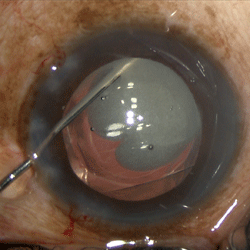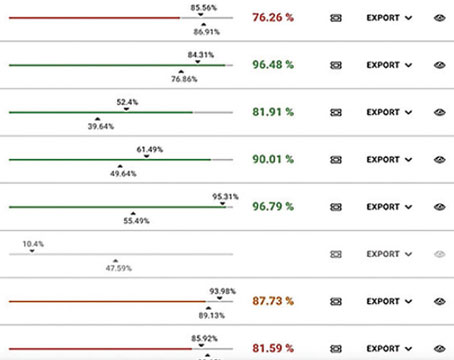TriMoxi/TriMoxiVanc
San Diego-based Imprimis Pharmaceuticals is currently in the process of finalizing an agreement with Randoph, N.J., compounder Pharmacy Creations to provide Imprimis’ formulations of intraoperative injections of triamcinolone/moxifloxacin and triamcinolone/moxifloxacin/vancomycin. James Lewis, MD, of Elkins Park, Pa., uses a trans-zonular infusion of both TriMoxi and TriMoxiVanc and has noticed some advantages. “We no longer have problems with compliance or corneal toxicity from the drops,” he says. “We also save the patients a good deal of money. But, more important, we save them aggravation from such issues as: ‘Will my insurance pay for the drops? Will I have to call to get a generic because the brand is too much? Do I have to go from a b.i.d. branded drug to a q.i.d. generic? Will the generic work well? Will it sting? What if I travel somewhere and don’t have the bottle with me; can I get another one at a pharmacy?’ Probably the biggest thing is that patients simply don’t like the mess of putting in eye drops, and can have difficulties with physically administering them. Family members can do it for them, but unless they live with the patient it’s a two- to four-time-a-day obligation for a month. The infusion does away with all of this.”
John Saharek, vice president of commercialization for Imprimis’ ophthalmology division, says the company is trying to close the deal with Pharmacy Creations by the end of March 2014, though the pharmacy can currently ship to “many of the Eastern Seaboard states,” he says. Though the company hasn’t established prices for the formulation yet, physicians in one of the states served by Pharmacy Creations can currently get a TriMoxi compound from the pharmacy for $40 and a TriMoxiVanc for $45, with a prescription.
DuoCat
Researchers at the Brazilian Ocular Pharmacology and Pharmaceutical Technology Research group have developed an injectable compound that combines an anti-inflammatory and an antibiotic in microsphere form. In the group’s studies, they combined triamcinolone and ciprofloxacin for the microsphere injection.
“The microspheres are placed with a sub-Tenon’s injection immediately after surgery to create a time-release system,” explains Jose Cardillo, MD, who was lead author on one of the DuoCat studies. “In the beginning our main goal was to keep patients out of unnecessary eye drops but, after researching the method, we proved pharmacokinetically in a study of a single drop vs. this system that the microsphere injection can reach a higher level of antibiotic in the anterior chamber and the vitreous.”1
|
Dr. Cardillo and his co-workers met with the U.S. Food and Drug Administration about possible approval of the post-cataract system in the United States, but the agency required proof that the system prevented endophthalmitis, a process that would take millions of patients, owing to the already-low incidence of endophthalmitis. Such a trial was beyond his group’s resources and, right now, the researchers say they may need a corporate partner to take the idea further. “We know it works clinically and may be an important method for the patient,” Dr. Cardillo says. “We maybe need a company to purchase the idea—not actually the product but the idea—and help us develop it in a more commercial way.”
The Pros and Cons
Though many surgeons would be interested in intraoperative injection/infusion, they have some questions about the modality, too.
• Compounding pharmacy fears. Probably chief among ophthalmologists’ concerns about any intraocular injection or infusion is the quality of the compounder who made it. Their concerns are well-founded: The passage of the 2012 Drug Quality and Security Act came in the wake of the deaths of 49 people out of 751 confirmed or probable fungal meningitis cases that were linked to drugs compounded at the New England Compounding Center. In addition, there have been cases of endophthalmitis linked to anti-VEGF injections that were mixed at compounding facilities.
Imprimis’ Mr. Saharek says that Pharmacy Creations complies with both the mandatory state regulations and the more stringent regulations of the Pharmacy Compounding Accreditation Board, which mandates, among other things, an on-site inspection. “We have a pharmacy that’s PCAB-accredited, which is one of the higher standards in terms of compounding pharmacies,” he says. In the future, Imprimis’ compounding facility may also require further voluntary oversight by the FDA if the drugs in its compounds are included on an FDA list of agents, since the company would ultimately like to achieve “outsourcing facility” status. As an outsourcing facility, the site would be subject to spot checks by the agency, but would also be able to produce compounded injections that surgeons could store at their offices and use as-needed without having to submit a prescription. “Regardless of whether the drugs are on the FDA list,” Mr. Saharek says, “the state and PCAB oversight are pretty stringent requirements.”
• Pharmacokinetics. There’s also the question of how long an injection would last vs. daily drops. Though TriMoxi and TriMoxiVanc haven’t been specifically studied in trials for duration, surgeons who have injected them and similar compounds say they appear to last long enough.
Warwick, R.I., surgeon Paul Koch used a compounded intraocular steroid and antibiotic for cataract surgery for two years until one of the agents he used, Tequin (gatifloxacin), was taken off the market. “I believe when the studies were done back [when I used it] the injection’s duration wasn’t as long as drops’, but it was long enough,” he says. “It was fine. Speaking of antibiotics, there actually is no evidence that antibiotic eye drops, either preop or postop, affect the rate of infection after surgery. The only studies that show elements that can effect endophthalmitis rates are draping the lids, preop Betadine and opening the posterior capsule. There are a lot of studies that show that using antibiotics reduces the bacterial load on the surface of the eye, but that hasn’t translated into a reduction of the rate of endophthalmitis. However, intracameral antibiotics have shown a decrease in endophthalmitis based on the European studies.
“With regard to steroids and non-steroids being used in surgery, yes, there is an effect there with the injection,” Dr. Koch says. “When we were doing the injections, we found that 94 percent of patients had enough steroid onboard to recover from the procedure very quickly and 6 percent had to have supplemental steroid eye drops after surgery for rebound iritis or any sort of discomfort.” He says the Kenalog left patients’ vision blurry for a couple of days since they injected it into the anterior chamber.
• Steroid responders. Surgeons who use postop drops will occasionally have a patient who has an intraocular pressure spike from the steroid, and can just discontinue the drop and maybe initiate pressure-lowering therapy. But what if the steroid responder had steroid injected directly into the eye?
“We were concerned about that as well,” says Dr. Koch. “But in the two years we were doing it, we never had to face that situation. So whether it’s a real concern and we were just fortunate or the doses we were using didn’t matter, I don’t know. We looked at that closely. We did see pressure rises on the first day, and sometimes we thought it was the Kenalog blocking trabecular meshwork. We studied it and found that the rate of the elevated pressure with the irrigation was exactly the same as our postop rate without the irrigation; we were just more cognizant of it when the Kenalog was in the eye.”
• Standard of care? Though Drs. Cardillo and Koch point out that the use of steroid and antibiotic drops after cataract surgery is actually an off-label use, there’s still the impression in the specialty that it’s become the standard of care. This impression could hurt a surgeon who performs a steroid/antibiotic injection in a patient who then develops a problem. “The problem is there are so many people who say using two or three drops is a standard of care and are willing to get paid to testify that way,” says Dr. Koch. “And the person who’s not doing it is on the defensive, even if they may be completely correct. I think that is shying a lot of people away from using it, though I think that’s incorrect.” REVIEW
1. Cardillo JA, Paganelli F, Melo Jr L, The Brazilian Ocular Pharmacology and Pharmaceutical Technology Research Group. Subconjunctival Delivery of Antibiotics in a Controlled-Release System. Arch Ophthalmol 2010;128:1:81-87.
2. Paganelli F, Cardillo J, Melo L, The Brazilian Ocular Pharmacology and Pharmaceutical Technology Research Group. A single intraoperative sub-tenon’s capsule injection of triamcinolone and ciprofloxacin in a controlled-release system for cataract surgery. Invest Ophthalmol Vis Sci 2009;50:7:3041-3047.






